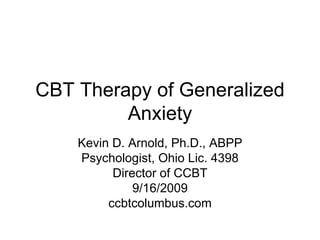Treatment of generalized anxiety
- 1. CBT Therapy of Generalized Anxiety Kevin D. Arnold, Ph.D., ABPP Psychologist, Ohio Lic. 4398 Director of CCBT 9/16/2009 ccbtcolumbus.com
- 2. About CCBT The Center for Cognitive and Behavioral Therapy of Greater Columbus 4624 Sawmill Rd., Columbus, OH 43220 614-459-4490 www.ccbtcolumbus.com [email_address]
- 3. What is Generalized Anxiety? Over Appraisal of Risks/Harm Chronic Most of the Day, Most Days Lack of Control of Thoughts Physiological Arousal Disruption to Functioning (e.g., irritability, decrease in life satisfaction, restriction of activities in one or more areas)
- 4. Treatment of Generalized Anxiety Use of Habituation through Thought Flooding Assessment of Worrisome Thoughts Creation of Graduated List Design and Prescription of Exposure Therapy through Thought Flooding Development of Motivation to do Daily Homework Coupling with Cognitive Restructuring
- 5. Treatment of Generalized Anxiety Cognitive Restructuring Development of Reality Testing Strategies Rerating Believability Rerating Exaggerated Prediction Probabilities Development of New Cognitions Accurate Probability Creation of Competency to Cope Practice, practice, practice
- 6. Treatment of Generalized Anxiety Relaxation to Manage Physiologic Arousal Use of Deep Breathing Strategies Focused Attention on Rate Focused Attention of Physical Sensations Attention to Stomach to Monitor Diaphragmatic Breathing Temperature of Air (cold in, warm out) Proprioceptive Sensation in Chest with Inhaling and Exhaling Use of 16 PMG Relaxation Head (face, eyes, mouth, jaw), Neck, Upper Shoulders, Lower Shoulders, Back, Chest, Stomach, Upper Arms, Lower Arms, Hands, Thighs, Calves, Feet
- 7. Treatment of Generalized Anxiety Alternative to 16 Progressive Muscle Group Relaxation Recall Based Relaxation Same areas, but use of suggestion Counting Backwards by 5s Use of Repeated Focus on Relaxation of all Groups Recursively Focus Attention on Deepest State Reduction in # in Muscle Groups Cued Relaxation through Deep Breathing
- 8. Treatment of Generalized Anxiety Relaxation Homework Rate Relaxation and Concentration as Highest Reached Do 2x per day Research suggests 2x per day improves outcomes Use Tape with Recording Sheets Pair Relaxation with Times Most Likely to Worry to Associate Worry Thoughts with Relaxation (Counter-conditioning)


![About CCBT The Center for Cognitive and Behavioral Therapy of Greater Columbus 4624 Sawmill Rd., Columbus, OH 43220 614-459-4490 www.ccbtcolumbus.com [email_address]](https://image.slidesharecdn.com/treatmentofgeneralizedanxiety-100714083735-phpapp02/85/Treatment-of-generalized-anxiety-2-320.jpg)





